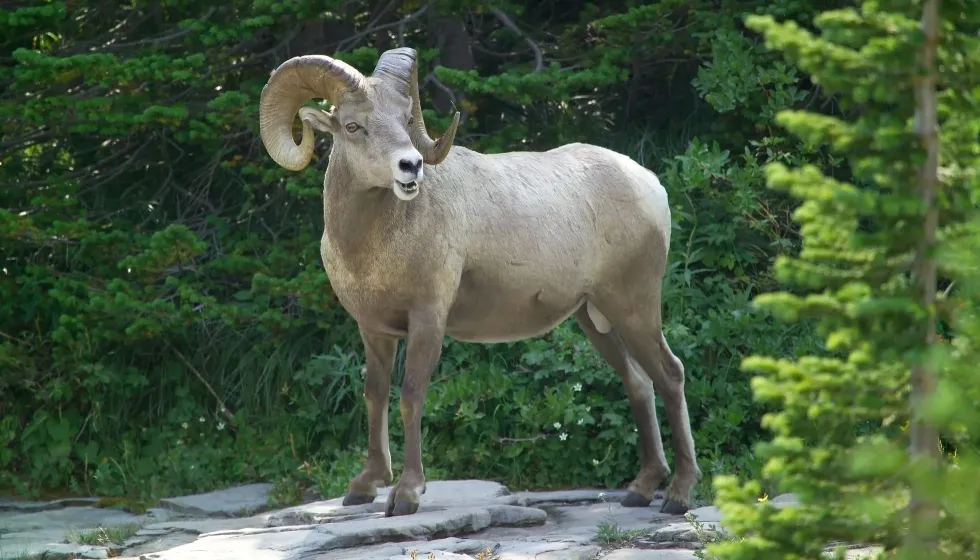Ovis vignei, or the urial, is a member of the wild sheep family. It belongs to the Ovis genus, and there are at least nine subspecies of it that can be identified on the basis of their size.
The males show off a different neck-ruff color during the winter months, which is another factor that helps identify different species. These animals are found in herds in the central and western parts of Asia.
These animals have furry bodies and have a beard near the chin. Urials are herbivorous and can be found feeding on shrubs and grass.
The availability of food is an important factor, which determines their habitat. The mating season of urials is between November and December when a ewe gives birth to a lamb.
The little lamb stays in the care of its mother for some time, after which it becomes independent. A fun fact about Urials is that a ewe can identify its young one on the basis of scent.
Included in this article is information regarding urial ram, urial steppe, Afghan urial, Punjab urial, urial sheep male and females, and so on.
You may also check out dall sheep facts and bighorn sheep facts from Kidadl.
Urial Interesting Facts
What type of animal is a urial?
Urial, or Ovis Orientalis, is a species of wild sheep.
What class of animal does a urial belong to?
Urials, which belong to the genus Ovis, have at least six subspecies. All of these belong to the class of Mammalia. Ovis vignei or Ovis orientalis is its scientific name.
How many urials are there in the world?
The exact count of Ovis Orientalis, or urials, is unknown. However, the count of Afghan urials is known, which is one of its many subspecies. There are only 145 sheep of this species.
Where does a urial live?
Urial sheep species are found in the wild areas. They prefer a grassy terrain with an abundance of food and also partly wooded areas. You can also spot urials in certain mountain regions.
What is a urial habitat?
Urials are found in the wild regions of Iran, India, Oman, and Armenia. They are found in the western parts of Asia, while a few species of this sheep is restricted to certain habitats only. The Ladakh urial (Ovis vignei vignei) is restricted to the Ladakh landscape, while the Transcaspian urial is found in the rolling terrains of India.
Who do urials live with?
A urial, or Ovis Orientalis, is found in the wild areas, living in a group. There are several group names of these sheep species, like a flock, mob, herd, and so on. The rams which have aged are found in different groups.
How long does a urial live?
Urials (Ovis Orientalis) can live up to 12 years.
How do they reproduce?
Urials belong to the subspecies group in the family of sheep. The mating habit of a urial is polygynous. The mating season of this species begins in November and continues only till December.
Rams and ewes become sexually mature after one to two years. After a gestation period of five months, a ewe gives birth to a lamb, while older ewes can give birth to even more. After its birth, a lamb stays with its mother for five or six months.
What is their conservation status?
Urials (Ovis vignei), which belong to the subspecies group of sheep, have been tagged as Vulnerable. This status varies according to its various species. The urials of Ladakh (Ovis vignei vignei) are considered to be Threatened, while the remaining species are considered Endangered.
Urial Fun Facts
What do urials look like?
The males of this species of sheep have large horns, while those of the females are smaller in comparison. These horns are curly and continue from the top to behind their oval head.
They have a furry body, which is absent from their legs. This fur is reddish-brown in color, which fades with the onset of winter. There are at least nine species of urials, each varies in its size and color, especially the neck-ruff.
How cute are they?
Urials and all their subspecies are not very cute to look at. They have massive longhorns, which might be scary. However, the lambs are very cute though.
How do they communicate?
A urial (Ovis Orientalis) belongs to the family of sheep. These species have a communication much similar to the sheep. They communicate by bleating loudly and also maintain visual contact with their entire group.
How big is a urial?
A urial is a mammal with large horns. The height of these sheep ranges from 35-39 in (80-90 cm). This makes them at least two times taller than a regular wild goat.
How fast can a urial run?
The exact speed of urials is not known. But since they belong to a sheep family, it can be expected that they can run fast. Their speed might be similar to a sheep, around 25 mph (40 kph).
How much does a urial weigh?
The weight of urials ranges between 110-198 lb (50-90 kg). They weigh almost the same as bighorn sheep but less than cape buffalo, who weigh 15-20 times more than urials.
What are the male and female names of the species?
The males of this sheep species are called rams and the females are known as ewes.
What would you call a baby urial?
A baby urial is called a lamb.
What do they eat?
The diet of a urial is formed by grasses and various kinds of shrubs. They may also feed on grains. These animals are herbivorous in nature. They prefer to live in areas that are filled with leafy vegetation. In the winter months, you can notice urials coming down to lower altitudes to search for food.
Are they dangerous?
Urials are docile creatures that are not dangerous in general. But they do have large horns and are a subspecies of wild sheep. They can become quite dangerous if provoked.
Would they make a good pet?
No, urials should not be kept as pets. They have large horns and might turn aggressive at times.
Did you know...
Ovis vignei, or commonly called urials, belong to the genus Ovis. An interesting and fun urial fact is that their neck-ruff can change its color during the winter months. Did you know that the urials are regarded as the ancestor of domestic sheep? It is considered to be one of the oldest sheep species in this line.
Sheep and all their family members, including urials, are known to have extensive memories. They can remember both their flock members and people for years. Another interesting fact is that urials are known to practice self-medication when they fall ill.
Why are they called urial?
Urial, which is scientifically named Ovis Orientalis, is a type of wild sheep. The literal meaning of this name is a wild sheep that have long legs. It indicates a sheep that has smaller horns compared to its body. But in reality, though, urials have large curly horns. Urials also go by other names like shapo or arkars.
Why is the Urial endangered?
A urial (Ovis Orientalis) which belongs to genus Ovis, is classified as Vulnerable by the IUCN Red List. The main threats of urials are humans and the destruction of their habitat.
They are largely dependent on their habitat for food. But this habitat is getting converted to agricultural land, which is proving dangerous to this species. Humans pose another threat to urials by indiscriminately hunting them for trophies.
Here at Kidadl, we have carefully created lots of interesting family-friendly animal facts for everyone to discover! For more relatable content, check out these llama facts and blue sheep facts for kids.
You can even occupy yourself at home by coloring in one of our free printable Urial coloring pages.









